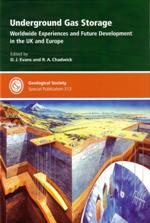D J Evans and R A Chadwick (eds)
Published by: The Geological Society of London
Publication date: July, 2009
ISBN: 978-1-86239-272-4 (hbk)
List price: £90.00; GSL member price: £45.00
360 pp
www.geolsoc.org.uk/bookshop

Underground Gas Storage (UGS) is currently a hot geopolitical topic. With the current energy climate, rising concerns regarding security of energy supply and environmental degradation, this publication is most timely.
The continuing gas supply and transit dispute between Russia and Ukraine has obvious implications for the rest of Europe’s gas consumers. The average European country's natural gas storage capacity is of the order of 20% of annual demand, compared to the UK's total capacity of less than 5%. By 2010 it is predicted that up to 40% of UK gas supply could be imported and by 2015 up to 80%. This is due to a decline in indigenous gas supplies, principally from the North Sea, coupled with an increase in demand. In order to ensure future security of supply, in terms of availability and reliability, a diversity of supply sources and UK entry points, and the ability to store large quantities of gas are essential. In the event of supply disruption, lack of storage would leave the UK in a particularly vulnerable position.
Energy security has also raised the possibility of a new generation of coal-fired power stations, which in order to be environmentally sustainable will require near zero CO
2 emissions. A key element in achieving this goal will be carbon capture and underground storage. This book reviews the technologies and issues associated with storage of natural gas and CO
2 by means of case studies and examples from the UK and overseas. The potential for underground storage of hydrogen and of compressed air energy (linked to renewable energy) is also reviewed.
Geological storage options for gases underground are clearly explained, together with the associated geomechanical, environmental, community safety and public confidence issues. The editors have succeeded in pulling together, from the various contributing authors, a series of very cogent and high quality contributions on all these issues. The book is well produced with good supporting figures and diagrams.
This publication is highly recommended as an essential primer on underground gas storage for geologists and other professional practitioners, as well as for those with a general interest in this extremely important field of geoscience.
Martin Broderick
Golder Associates, Oxford